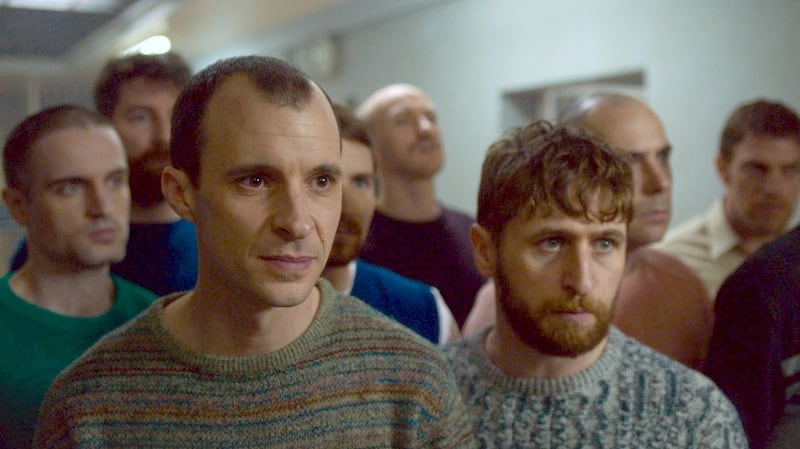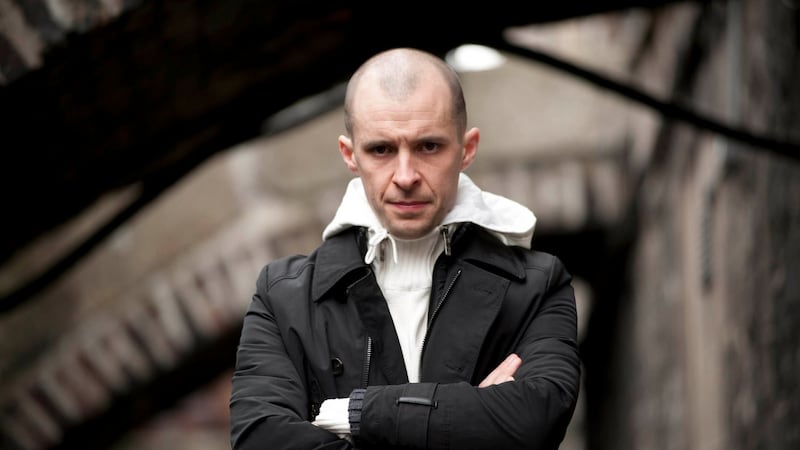Tom Vaughan-Lawlor is awfully chipper for a man who got up 5am to catch a flight to Dublin. “My son just about woke up to ask me where I was going,” says the actor. “Then he asked me to bring back chocolate and went straight back to sleep. He’s a very easygoing kid.”
He is also, apparently, accustomed to being part of a family that, as his dad has it, "goes where the wind blows you". During the summer, the clan found themselves in three time zones. Tom was shooting in the US, his wife, the actor Claire Cox, was in Budapest shooting Jamestown for Sky TV, and their son, six-year-old Freddie, was in Kent with his grandparents.
Tom shakes his head and smiles: “We try to mix and match so someone is always at home, but it doesn’t always work out perfectly. You know those lifestyle questionnaires where you’re asked ‘What do you owe your parents?’ About 20 grand in childcare. All our friends think we’re crazy. The ones that don’t act, that is.”
Tom already has quite the track record in biopics, having previously essayed Patrick Pearse and PJ Mara. Still, playing IRA volunteer Larry Marley in Stephen Burke's Maze – a film about the 1983 escape in which 38 inmates fled the infamous prison – proved to be quite a history lesson.
“To my shame, I had to educate myself about the Northern Irish conflict from the early 1960s on,” he says. “It was sobering, because growing up as middle-class kid in Dublin, it was just background noise.I knew about the hunger strikers. I had a vague recollection of the escape. But those things might as well have happened on another planet. And then you read about it and think of all the things that were happening just an hour’s drive away. And you suddenly rethink the entire island and what Irishness means.”
As Maze begins, Larry Marley has come off the blanket protest and joined his OC (Martin McCann) in a wing occupied by both Republican and Loyalist prisoners. Tensions run high as Larry attempts to ingratiate himself with the warden (Barry Ward), with an escape plan in mind.

“Playing prisoners, there’s a certain anarchism and a kind of punk energy,” says Tom. “That’s not to make it sound flippant. But there’s a potency about all that young male energy in such a confined space. One of the things I had to get my head around was their ability to endure those conditions for years. I couldn’t do it for a few days. That feeling of not getting out. And we shot in the old Cork prison in April. It had been a working prison until February. So that lent another kind of intensity.”
The actor is particularly proud of the new film’s willingness to touch on the extended family experience. “You can understand about singularity of purpose in young men who see themselves as revolutionaries. They are part of a culture and history of protest that has an energy and vibrancy that can be overwhelming. But what I like about our film is that that intensity is offset by the female experience. By women trying to keep their families together, and pay the bills, and feed their children, while the men chose a political path.”
A Love/Hate thing
It's not uncommon for an actor to surprise (or disappoint) by refusing to have anything in common with his or her most iconic work. Tom Vaughan-Lawlor takes this brand of dissonance to an entirely new level. A dapper, chapeaued chap with cheeky features that visually place him well shy of his 39 years, Vaughan-Lawlor could conceivably walk through a Love/Hate fan convention without being spotted by his most ardent admirers.
The success of Love/Hate, a show that drew almost a million domestic viewers per episode and which The Guardian and other media outlets compared favourably to such American big-hitters as The Wire and The Sopranos, snuck up on the actor.

“The first series, second series, even the third series, we were left completely alone on the streets,” he recalls. “But by the fourth series, people started turning up at locations. People were offering cups of tea and checking if we wanted to use their loo. I remember there was this one scene – one of the hardest pieces of acting I’ve ever done – I was driving into a car park and I’m supposed to be really paranoid and worried that I’m being watched. So I pull in and stop just in front of a camera and there are 300 people behind the camera all looking on. It was fun. Like being in a rock band.”
Vaughan-Lawlor's IRL non-Nidgeness is, unquestionably, a testament to his mad acting chops, a skillset that has landed him screen work alongside such well-known talents as Anne Hathaway (Becoming Jane), Bryan Cranston (The Infiltator), Rooney Mara (The Secret Scripture) and Ellen Page (The Cured, David Freyne's incoming post-zombie dramedy). It's an impressive series of collaborations for an artist who imagined his career would be entirely theatrical.
He graduated with a degree in Drama Studies at the Samuel Beckett Centre, Trinity College Dublin and continued his training at Rada: “I remember going to Rada and thinking I’ll be the toughest person there,” he laughs., “You know, fought my way up from the mean streets of Rathgar. But no.”
Back then, neither of these institutes was geared toward film and television, and the actor is still a bit surprised to find himself not treading the boards
“When I went to drama school, training for the screen wasn’t really a thing,” says Vaughan-Lawlor. “I think it is now. But at that time, theatre was where your identity was as an actor. You studied theatre and theatre history. Especially where I trained in London. That was that tradition. Theatre is your lifeblood – I understand that. I love that. And I love trying to bring the rigour of the rehearsal room to screen work.”
Child of the boards
Growing up, Vaughan-Lawlor, the son of an actor, had occasional roles at the Abbey and the Gate, but “only because my dad would be in a show and they’d need a kid and I’d have nothing else to do”. Having experienced first-hand the financial instability and headspace required for the job, he had no intention of following in his father’s footsteps. “It completely put me off. Being in a house with an actor and four kids. Because I realised how tough that life is. Especially in theatre.”
So how on earth did he wind up in the Samuel Beckett Centre?
“I wanted to write plays. But it turned out I wasn’t very good at that.”
Happily, he was rather better at being in plays. Post-Rada he soon made his mark in The Quare Fellow directed by Kathy Burke; in This Lime Tree Bower for the Young Vic; as the titular rogue in the Abbey Theatre's touring production of The Playboy of the Western World; and in Howard Davis 2010 West End production of All My Sons.
“I think theatre requires a different kind of engagement as an audience member. You can take your wife to an Ibsen play about marriage being total bollix and allow it to challenge you.
When theatre gets it right, and you hear a pin drop, there’s no energy like it. Of course, when theatre is bad, its really bad: it’s you-want-to-kill-yourself bad.”
Vaughan-Lawlor has won Irish Times Best Actor Theatre Award twice – in 2009 for The Resistible Rise of Arturo Ui, and in 2014 for his dual performances in Mark O'Rowe's Howie the Rookie. And he received an Ian Charleson Award commendation for 2008 his portrayal of the Dauphin in Henry V at the Royal Exchange Manchester.
“The more shoes you fill, the more enlightened you get, I think,” he says. “One of the great thing about being an actor is that it educates you. If you’re doing a restoration comedy and learning about 17th century mannerisms – or doing a film about the Deep South during the Civil War, it stretches your understanding of history and people. It feeds you as a person, makes you better.” He laughs. “Although maybe my wife might disagree.”
Does he ever unintentionally bring work home?
“Sometimes, yes. There’s always a residue when you’re channelling certain things. But if I come home and I’m still a bit wired, my wife will send me to get a shower have a cup of tea. Because she’s an actor too. So she gets it .”
It's just as well Claire Cox is understanding. Vaughan-Lawlor did take her to a remote cottage in Dunmore East. In the dead of winter. With a box-set of Six Feet Under. For their honeymoon. Huh?
“I know. It’s possibly the worst show you could binge watch on honeymoon, ever,” he smiles. “Especially when it’s December in Dunmore East. Oh, and my wife was eight months pregnant. Even the woman we rented the cottage from was, like: ‘Do you have relatives here? Are you sure about this?’ But it was an adventure.”
Marvel awaits
Last July, various media outlets went into meltdown when photographs emerged of Benedict Cumberbatch recording a fight scene for Avengers: Infinity War with a chap in a dotted CGI suit who looked awfully like Vaughan-Lawlor. By now, the dogs on the street can reveal that he is playing Thanos's general Ebony Maw. But he can't.
"I'm working with an amazing guy called Terry Notary (Kong: Skull Island, Holy Motors) who is such an incredible actor," says Tom. "But I'm not allowed to say anything more. I get it. The internet such a force for spoilers and leaks and the film is such a huge deal for so many people, it would be horrible to spoil it. But even though you have to sign a lot of forms, the Marvel people are really gorgeous. You think: 'Oh, it's Marvel, it's like a machine', but everyone you meet – even the really senior people - are artists."
- Maze is out now on general release
Great Escapes - Five great prison break movies
THE GREAT ESCAPE (1963)
Well, duh! Steve McQueen heads a huge, starry cast, all used cunningly, in the tale of the breakout from Stalag Luft III. Unbeatable.
PAPILLON (1973)
Henri Charrière's trueish tale of an escape from Devil's Island was one of the era's biggest sellers. The film paired up Dustin Hoffman and (him again) Steve McQueen to good effect. Currently being remade with Charlie Hunnam and Rami Malek.
THE SHAWSHANK REDEMPTION (1994)
Does this count? Well, the final breakout is among the more famous moments in 1990s cinema. So it has to be here. Not quite "the greatest film of all time", despite what many say.
MIDNIGHT EXPRESS (1978)
Probably still Alan Parker's best film. Brad Davis is superb as an American banged up in Turkey for drug smuggling. Racially a bit iffy now, but gripping.
THE COLDITZ STORY (1955)
Much-loved bank holiday entertainment derived from a memoir by Pat Reid. Later became one of the biggest telly hits of the 1970s.












